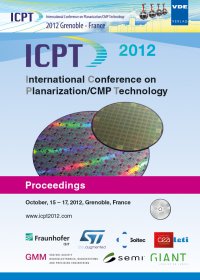Development of new copper post-CMP cleaning solutions that allow direct bonding
Conference: ICPT 2012 - International Conference on Planarization / CMP Technology
10/15/2012 - 10/17/2012 at Grenoble, France
Proceedings: ICPT 2012
Pages: 6Language: englishTyp: PDF
Personal VDE Members are entitled to a 10% discount on this title
Authors:
Ouerd, Aziz; Dulphy, Hervé; Lelièvre, Vincent (Air Liquide Electronics Systems, 8 rue des Méridiens 38433 Echirolles Cedex, France)
Cioccio, Léa Di (CEA Léti – MINATEC, 17 Rue des Martyrs, 38054 Grenoble Cedex 9, France)
Rivoire, Maurice (STMicroelectronics, 850 Rue Jean Monnet, 38926 Crolles Cedex, France)
Abstract:
Direct wafer bonding is considered as one of the most promising approaches for 3D IC applications [1]. It refers to a process by which two mirror-polished wafers are put into contact and held together at room temperature by adhesive forces, without any additional materials [2]. Direct wafer bonding can be achieved in clean room at room temperature with ambient air, without any pressure and without any adhesive materials, and the process can be feasible at industrial scale as demonstrated in the silicon-on-insulator mass production [3]. High bond strength and void-free bonding interface are required in order to provide reliable and high-performance devices. Whatever the material nature, wafer surfaces have to be contamination free (particle and organic) and smooth enough to adhere to each other [4]. Before bonding, wafers are submitted to CMP process that results in the presence of slurry particles and organic contamination at copper surface. For this reason, the performances of post-CMP cleaning process and solutions, and their ability to remove the contamination without generating defects are mandatory. Based on a wide knowledge of CMP and cleaning solutions design, a new generation of post-CMP cleaning chemistries has been developed in recent years to meet the very stringent requirements of Cu-Cu direct bonding surfaces. This paper reports the results of a comparative study between two generations of copper post-CMP cleaning solutions. The main differences in electrochemical behavior, surface morphology and subsequent direct bonding performances of copper wafers cleaned with these solutions are detailed. Keywords: Direct bonding, cleaning solutions, EIS, surface morphology.


